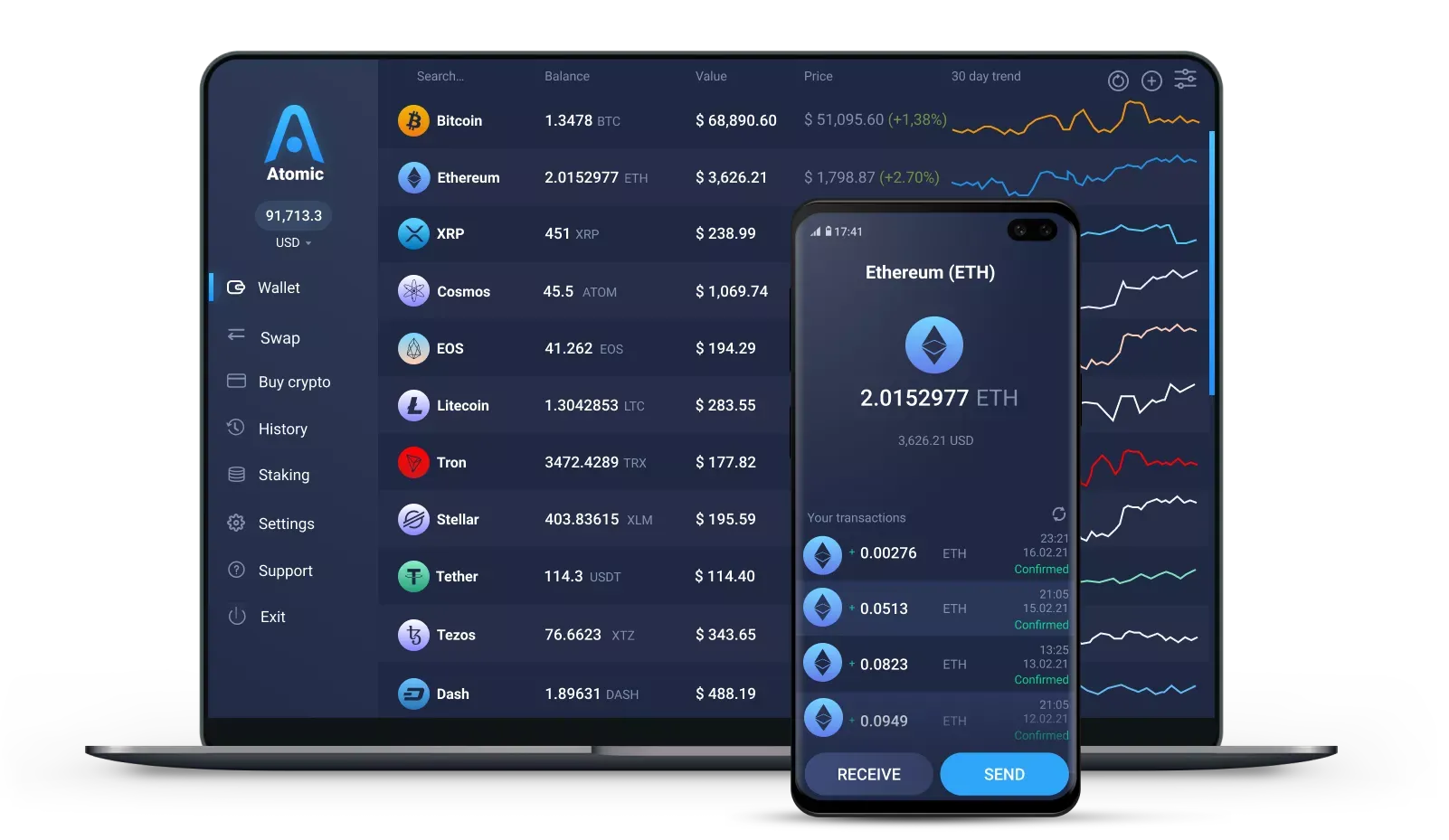Trusted Reviews
Why Choose Atomic Ethereum wallet
What is Ethereum Wallet?
Diving into the world of cryptocurrency begins with understanding the basic tools, particularly wallets. For those interested in Ethereum, a leading cryptocurrency, knowing your ethereum wallet options is crucial.
Understanding Ethereum Wallets
An Ethereum wallet, like other cryptocurrency wallets, is a digital tool that allows you to store, send, and receive Ethereum (ETH). It's akin to a bank account for your digital currency. However, unlike a traditional bank account, an Ethereum wallet gives you full control over your assets. It uses a pair of cryptographic keys: a public key, which is your wallet address, and a private key, which is like your password.
Ethereum wallets come in various forms. Some are software-based and exist on your computer or smartphone, offering convenience and easy access. Others are hardware devices that store your keys offline, adding an extra layer of security.
There are also online wallets, which are web-based, and paper wallets, which are physical printouts of your keys. Each type of wallet has its unique set of features, benefits, and security measures.
A few examples of Ethereum wallets include Atomic Wallet, a user-friendly option used by over 5,000,000 users worldwide; Ledger Wallets, which offer high security by storing keys and signing transactions offline; and Trust Wallet, known for its strong safeguards and optimized Web3 experience.
Importance of Ethereum Wallets
Ethereum wallets play a crucial role in managing and utilizing your Ethereum. They provide a secure and personal way to manage your assets, which is essential in the decentralized world of cryptocurrencies.
Your Ethereum wallet allows you to participate in the wider Ethereum ecosystem. It enables you to send and receive Ethereum, participate in DeFi (Decentralized Finance) applications, and even create and interact with smart contracts on the Ethereum blockchain.
Without an Ethereum wallet, you would not be able to access or control your assets. Therefore, choosing the right Ethereum wallet that suits your needs and ensures the safety of your assets is paramount.
In the following sections, we'll explore in detail the features and benefits of various Ethereum wallets, helping you to make an informed decision about the best one for your needs. This includes popular options like Atomic Wallet, Ledger Wallets, MyEtherWallet (MEW), and Trust Wallet.
Remember, the safety of your assets should be your top priority when choosing an Ethereum wallet. Always consider the reputation, security features, ease of use, and compatibility with other platforms when evaluating your options.
Review of Atomic Wallet
As a beginner investor venturing into the world of cryptocurrency, one of the essential tools you'll need is a reliable Ethereum wallet. One such wallet that has gained popularity among users around the globe is the Atomic Wallet.
Features of Atomic Wallet
Atomic Wallet is a trusted Ethereum wallet being used by over 5,000,000 users worldwide. It provides a range of features that cater to the diverse needs of cryptocurrency investors. This Ethereum wallet allows users to securely store, swap, and stake Ethereum and Non-Fungible Tokens (NFTs), as well as other crypto assets.
One of the key features of Atomic Wallet is the ability to swap Ethereum for over 1000+ crypto pairs anonymously. This feature gives users the flexibility to diversify their crypto portfolio without having to rely on multiple wallets or exchanges.
Further, Atomic Wallet supports buying Ethereum and 20+ other assets using a bank card, accepting USD, EUR, and other local currencies across the world. This makes it a convenient choice for those who want to buy Ethereum directly from their wallet.
Moreover, for users interested in earning passive income from their crypto assets, Atomic Wallet offers a staking feature. By staking Ethereum on Atomic Wallet, users can earn an Annual Percentage Yield (APY) of 5% along with 10+ other assets.
Benefits of Using Atomic Wallet
There are several benefits of using Atomic Wallet as your preferred Ethereum wallet. Firstly, the wide range of features offered by Atomic Wallet makes it a versatile tool for managing your crypto investments. Whether you want to buy, swap, stake, or store your Ethereum, you can do it all from one platform.
Secondly, the ability to swap Ethereum for over 1000+ crypto pairs means you have the flexibility to diversify your portfolio as per your investment strategy. Plus, you can do this while remaining anonymous, adding an extra layer of privacy to your transactions.
In addition, the staking feature of Atomic Wallet allows you to earn passive income from your Ethereum and other crypto assets. This can be a great way to maximize your returns, especially in a volatile crypto market.
Lastly, Atomic Wallet supports buying Ethereum and other assets using a bank card and accepts various local currencies. This makes it a convenient and accessible choice for users across the globe.
In conclusion, Atomic Wallet is a powerful tool that offers a range of features to cater to the diverse needs of crypto investors. Whether you are new to the world of crypto or an experienced investor, Atomic Wallet can be a great choice for managing your Ethereum investments. Whether you're looking for an XRP wallet, a USDT wallet, or exploring how to stake Cardano, Atomic Wallet has you covered.
Choosing the Right Ethereum Wallet
When it comes to interacting with the Ethereum network, the right wallet can make a significant difference. With a range of options available, it's important to consider several factors to ensure you're choosing the best Ethereum wallet to meet your needs.
Factors to Consider
When selecting an Ethereum wallet, consider the following:
- Functionality: Look for a wallet that supports a wide range of operations, from simple transactions to more complex blockchain interactions like swapping, staking, and managing NFTs.
- Security: The wallet should offer robust security features to protect your assets. Look for wallets that store private keys offline, provide strong safeguards, or use advanced encryption methods.
- Ease of Use: The wallet should have a user-friendly interface that makes it easy to check balances, track transaction histories, and perform transactions.
- Compatibility: The wallet should be compatible with various platforms, such as desktop, mobile, or hardware devices.
- Support for Assets: Ensure the wallet supports Ethereum and other assets you plan to use. Some wallets also support all ERC-20 tokens.
- Additional Features: Some wallets offer additional features like the ability to buy Ethereum directly using a bank card in various currencies or earn crypto rewards.
Making an Informed Decision
Remember, it's not just about storing your Ethereum securely; it's about being able to interact with the Ethereum network in the way that suits you best. Whether that's staking to earn rewards, buying and selling on the go, or simply keeping your Ethereum safe, the right wallet is a key part of your Ethereum journey.




















